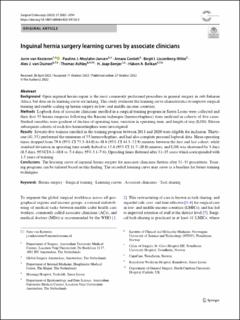| dc.contributor.author | van Kesteren, Jurre | |
| dc.contributor.author | Meylahn-Jansen, Pauline J. | |
| dc.contributor.author | Conteh, Amara | |
| dc.contributor.author | Lissenberg-Witte, Birgit I. | |
| dc.contributor.author | van Duinen, Aalke Johan | |
| dc.contributor.author | Ashley, Thomas | |
| dc.contributor.author | Bonjer, H. Jaap | |
| dc.contributor.author | Bolkan, Håkon Angell | |
| dc.date.accessioned | 2023-04-20T06:26:03Z | |
| dc.date.available | 2023-04-20T06:26:03Z | |
| dc.date.created | 2022-11-15T13:00:29Z | |
| dc.date.issued | 2023 | |
| dc.identifier.citation | Surgical Endoscopy. | en_US |
| dc.identifier.issn | 0930-2794 | |
| dc.identifier.uri | https://hdl.handle.net/11250/3063916 | |
| dc.description.abstract | Background
Open inguinal hernia repair is the most commonly performed procedure in general surgery in sub-Saharan Africa, but data on its learning curve are lacking. This study evaluated the learning curve characteristics to improve surgical training and enable scaling up hernia surgery in low- and middle-income countries.
Methods
Logbook data of associate clinicians enrolled in a surgical training program in Sierra Leone were collected and their first 55 hernia surgeries following the Bassini technique (herniorrhaphies) were analyzed in cohorts of five cases. Studied variables were gradient of decline of operating time, variation in operating time, and length of stay (LOS). Eleven subsequent cohorts of each five herniorrhaphies were investigated.
Results
Seventy-five trainees enrolled in the training program between 2011 and 2020 were eligible for inclusion. Thirty-one (41.3%) performed the minimum of 55 herniorrhaphies, and had also complete personal logbook data. Mean operating times dropped from 79.6 (95% CI 75.3–84.0) to 48.6 (95% CI 44.3–52.9) minutes between the first and last cohort, while standard deviation in operating time nearly halved to 15.4 (95% CI 11.7–20.0) minutes, and LOS was shortened by 3 days (8.5 days, 95%CI 6.1–10.8 vs. 5.4 days, 95% 3.1–7.6). Operating times flattened after 31–35 cases which corresponded with 1.5 years of training.
Conclusions
The learning curve of inguinal hernia surgery for associate clinicians flattens after 31–35 procedures. Training programs can be tailored based on this finding. The recorded learning curve may serve as a baseline for future training techniques. | en_US |
| dc.language.iso | eng | en_US |
| dc.publisher | Springer Nature | en_US |
| dc.rights | Navngivelse 4.0 Internasjonal | * |
| dc.rights.uri | http://creativecommons.org/licenses/by/4.0/deed.no | * |
| dc.title | Inguinal hernia surgery learning curves by associate clinicians | en_US |
| dc.title.alternative | Inguinal hernia surgery learning curves by associate clinicians | en_US |
| dc.type | Peer reviewed | en_US |
| dc.type | Journal article | en_US |
| dc.description.version | publishedVersion | en_US |
| dc.source.pagenumber | 2085–2094 | en_US |
| dc.source.volume | 37 | en_US |
| dc.source.journal | Surgical Endoscopy | en_US |
| dc.identifier.doi | 10.1007/s00464-022-09726-5 | |
| dc.identifier.cristin | 2074191 | |
| cristin.ispublished | true | |
| cristin.fulltext | original | |
| cristin.qualitycode | 2 | |

